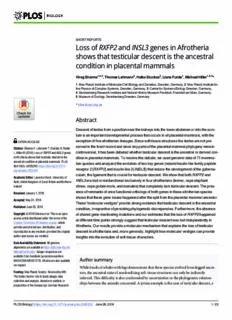
Loss of RXFP2 and INSL3 genes in Afrotheria shows that testicular descent is the ancestral PDF
Preview Loss of RXFP2 and INSL3 genes in Afrotheria shows that testicular descent is the ancestral
SHORTREPORTS Loss of RXFP2 and INSL3 genes in Afrotheria shows that testicular descent is the ancestral condition in placental mammals ViragSharma1,2,3,ThomasLehmann4,HeikoStuckas5,LianeFunke1,MichaelHiller1,2,3* 1 MaxPlanckInstituteofMolecularCellBiologyandGenetics,Dresden,Germany,2 MaxPlanckInstitutefor thePhysicsofComplexSystems,Dresden,Germany,3 CenterforSystemsBiologyDresden,Germany, 4 SenckenbergResearchInstituteandNaturalHistoryMuseumFrankfurt,FrankfurtamMain,Germany, 5 MuseumofZoology,SenckenbergDresden,Germany a1111111111 a1111111111 *[email protected] a1111111111 a1111111111 a1111111111 Abstract Descentoftestesfromapositionnearthekidneysintothelowerabdomenorintothescro- tumisanimportantdevelopmentalprocessthatoccursinallplacentalmammals,withthe OPENACCESS exceptionoffiveafrotherianlineages.Sincesoft-tissuestructuresliketestesarenotpre- servedinthefossilrecordandsincekeypartsoftheplacentalmammalphylogenyremain Citation:SharmaV,LehmannT,StuckasH,Funke L,HillerM(2018)LossofRXFP2andINSL3genes controversial,ithasbeendebatedwhethertesticulardescentistheancestralorderivedcon- inAfrotheriashowsthattesticulardescentisthe ditioninplacentalmammals.Toresolvethisdebate,weusedgenomicdataof71mamma- ancestralconditioninplacentalmammals.PLoS lianspeciesandanalyzedtheevolutionoftwokeygenes(relaxin/insulin-likefamilypeptide Biol16(6):e2005293.https://doi.org/10.1371/ receptor2[RXFP2]andinsulin-like3[INSL3])thatinducethedevelopmentoftheguberna- journal.pbio.2005293 culum,theligamentthatiscrucialfortesticulardescent.WeshowthatbothRXFP2and AcademicEditor:LaurenceHurst,Universityof INSL3arelostornonfunctionalexclusivelyinfourafrotherians(tenrec,capeelephant Bath,UnitedKingdomofGreatBritainandNorthern Ireland shrew,capegoldenmole,andmanatee)thatcompletelylacktesticulardescent.Thepres- enceofremnantsofoncefunctionalorthologsofbothgenesintheseafrotherianspecies Received:January1,2018 showsthatthesegenelosseshappenedafterthesplitfromtheplacentalmammalancestor. Accepted:May24,2018 These“molecularvestiges”providestrongevidencethattesticulardescentistheancestral Published:June28,2018 condition,irrespectiveofpersistingphylogeneticdiscrepancies.Furthermore,theabsence Copyright:©2018Sharmaetal.Thisisanopen ofsharedgene-inactivatingmutationsandourestimatesthatthelossofRXFP2happened accessarticledistributedunderthetermsofthe atdifferenttimepointsstronglysuggestthattesticulardescentwaslostindependentlyin CreativeCommonsAttributionLicense,which Afrotheria.Ourresultsprovideamolecularmechanismthatexplainsthelossoftesticular permitsunrestricteduse,distribution,and reproductioninanymedium,providedtheoriginal descentinafrotheriansand,moregenerally,highlighthowmolecularvestigescanprovide authorandsourcearecredited. insightsintotheevolutionofsoft-tissuecharacters. DataAvailabilityStatement:Allgenome alignmentsareavailableathttps://bds.mpi-cbg.de/ hillerlab/testicondy/.Sangersequencesare availablefromGenBank(accessionnumbers Authorsummary MH347268-MH347272).Alldataarealsoavailable onrequest. Whilefossilsofwhaleswithlegsdemonstratethatthesespeciesevolvedfromleggedances- Funding:MaxPlanckSociety.ReceivedbyMH. tors,theancestralstateofnonfossilizingsoft-tissuestructurescanonlybeindirectly Thefunderhadnoroleinstudydesign,data inferred.Thisdifficultyisalsoconfoundedbyuncertaintiesinthephylogeneticrelation- collectionandanalysis,decisiontopublish,or shipsbetweentheanimalsconcerned.Aprimeexampleisthecaseoftesticulardescent,a preparationofthemanuscript.GermanResearch PLOSBiology|https://doi.org/10.1371/journal.pbio.2005293 June28,2018 1/22 LossoftesticulardescentinAfrotheria Foundation(grantnumberHI1423/3-1).Received byMH.Thefunderhadnoroleinstudydesign, developmentalprocessthatdeterminesthefinalpositionoftestes,whichoccursinmost datacollectionandanalysis,decisiontopublish,or placentalmammalsbutisabsentfromseveralafrotherianlineages.Here,wediscovered preparationofthemanuscript.LeibnizAssociation thatafrotherianspossessremnantsofgenesknowntoberequiredfortesticulardescent. (grantnumberSAW-2016-SGN-2).Receivedby These“molecularvestiges”showthattesticulardescentwasalreadypresentintheplacen- TL,HS,MH.Thefunderhadnoroleinstudy talancestorandwassubsequentlylostinAfrotheria.Ourstudyhighlightsthepotentialof design,datacollectionandanalysis,decisionto publish,orpreparationofthemanuscript. molecularvestigesinresolvingcontradictoryancestralstatesofsoft-tissuecharacters. Competinginterests:Theauthorshavedeclared thatnocompetinginterestsexist. Abbreviations:CESAR,CodingExon-Structure Introduction AwareRealigner;INSL3,insulin-like3;Mya,million yearsago;RXFP2,relaxin/insulin-likefamily Inplacentalmammals—theeutheriancrowngroupconsistingofthecladesAfrotheria,Xenar- peptidereceptor2;SRA,SequenceReadArchive. thra,andBoreoeutheria[1]—optimaltesticularfunctionrequiresatemperaturethatislower thanthebodytemperature.Toachievethis,thetestesarelocatedoutsideoftheabdominalcav- ityinascrotuminmanyspeciessuchasprimates,mostrodents,lagomorphs,mostcarnivores, andmostterrestrialartiodactyls[2,3].Alternatively,testesarelocatedinthelowerabdomen indolphins,trueseals,pangolins,andothermammals.Inthesespecies,testicularcoolingis achievedbyvascularcountercurrentheatexchangersystems,asobservedindolphin[4];direct coolingwithbloodfromthehindlimbs,asobservedinseals[5];ortesticularcoolingmaynot benecessary,asthesespecieshavelowerbodytemperatures[2,6,7]. Thepositionofthetestesinthelowerabdomenorinthescrotumistheresultofadevelop- mentaldescentprocess(S1Fig).Duringmammaliandevelopment,testesinitiallyformata positionnearthekidneysintheembryo.Testiculardescentintothescrotumoccursintwo phases:firstfromtheabdomentotheinguinalcanalandsecondthroughtheinguinalcanal intothescrotum[8,9].Thefirsttransabdominalphaseisgovernedbythegrowthandreorga- nizationofthegubernaculum,aligamentthatconnectsthelowerpoleofthetestesandinner ringofthefutureinguinalcanal[8–10].Migrationofthetestesiscausedbytheswellingofthe distalgubernaculum,whichanchorsthetestistotheinguinalcanal,whiletheabdominalcavity enlarges.Thesecondinguinoscrotalphaseisdependentonandrogensignalingandrequires theelongationofthegubernaculum,whichmigratesintothescrotum[8–10].Theinvolved signalingandmechanicsmaketesticulardescentadifficultandcomplexdevelopmentalpro- cess.Failureinanyofthedescentphasesresultsinapathologicalconditioncalledcryptorchi- dism(absenceoftestesfromthescrotum),whichisacongenitalbirthdefectobservedatan appreciablefrequencyinhumanmales(2%–4%atbirth[11])andotheranimals(upto10%in maledogs[12],2%inmalecats[13],2%–8%inmalehorses[14]). Almostallplacentalmammalsexhibiteitherpartialdescent(onlythetransabdominal phase),whichresultsinascrotaltesteslocatedinthelowerabdomen,orcompletedescent (transabdominalandinguinoscrotalphase),whichresultsinscrotaltestes[2,3].Anotable exceptionisAfrotheria,inwhichfiveofthesixmainlineages(representedherebythelesser hedgehogtenrec,capegoldenmole,capeelephantshrew,manatee,elephant,androckhyrax) donotshowanytesticulardescentandhavetestespositionedattheirinitialabdominalposi- tionnearthekidneys[2,3,15–17].Thislackofanytesticulardescentistermedtesticondy. Theaardvarkistheonlyafrotherianexhibitingdescendedbutascrotaltestes[2,3,18].Asche- maticillustrationofthedifferentpositionoftestesinmammalsisshowninS1Fig. SinceAfrotheriarepresentoneofthethreemaincladesofplacentalmammals(together withXenarthraandBoreoeutheria),twodifferentevolutionaryscenarioscouldexplaintesti- condyinseveralafrotherianlineages.First,iftesticondyistheancestralconditioninplacental mammals,thentesticulardescentwasgainedtwoorthreetimes(dependingonthephylogeny) inXenarthra,Boreoeutheria,andtheaardvarklineage.Second,iftesticulardescentisthe PLOSBiology|https://doi.org/10.1371/journal.pbio.2005293 June28,2018 2/22 LossoftesticulardescentinAfrotheria ancestralconditioninplacentalmammals,thentesticulardescentwaslostonceormoreoften (againdependingonthephylogeny)infiveofthesixafrotherianlineages.Sincesoft-tissue structuresliketestesandthetransientgubernaculumligamentaretypicallynotpreservedin thefossilrecord,theevolutionofsuchsoft-tissuestructurescanonlybeinferredbyanalytical methodssuchasparsimony,extantphylogeneticbracketing,ormaximumlikelihood[19–22], allofwhichrelyonthegivenphylogenetictree.Consequently,resolvingwhethertesticondyor testiculardescentistheancestralconditioninplacentalmammalsrequiresaccurateknowledge oftheunderlyingphylogeny. Unfortunately,althoughintegrativeapproachesusingbothmorphologicalandmolecular charactershavebroughtmajoradvancesinourunderstandingofmammalianphylogeny[23– 26],thereisstillnofinalconsensusontherelationshipsbetween(andsometimeswithin)the maincladesofplacentalmammals.Inparticular,theplacentalrootandbranchingpatternof thecladesAfrotheria,Xenarthra,andBoreoeutheriaarestilldebated[26–28](S2Fig),andan analysisofraregenomiceventsraisedtheconcretepossibilityofanear-simultaneoussplit [29].Furthermore,thephylogenywithinAfrotheriaisnotwellresolved,becauseofconflicting evidenceforthepositionoftheaardvark(theonlynontesticondafrotherianlineage)andthe relationshipsbetweenmanatees,elephants,andhyraxes[30–34](S3Fig). Giventhesephylogeneticuncertainties,itisprobablynotsurprisingthattwodifferentstud- iesreachedoppositeconclusionsaboutwhethertesticondyistheancestralorderivedstatefor placentalmammalsandforAfrotheria.WerdelinandNilsonne[2]inferredthattesticular descentinplacentalmammalsandAfrotheriaistheancestralcondition(testiculardescentwas subsequentlylost).However,theirresultswerebasedonaphylogenyinwhichAfrotheriawere nestedwithinBoreoeutheria,whichisnotsupportedbycurrentphylogenies.Morerecently, Kleisnerandcolleagues[3]reexaminedtheevolutionoftesticulardescentinthecontextof currentphylogeniesandcametotheoppositeconclusionthattesticondyinplacentalmam- malsandAfrotheriaistheancestralphenotypiccharacter. Here,wesoughttoresolvethisdebatewhethertesticondyortesticulardescentistheances- tralconditioninplacentalmammalsandinAfrotheriabyusingmolecularevidence.First,we reasonedthatiftesticulardescentisancestral,thentesticondafrotherianlineagesmayhave lostkeygeneticinformationthatisnecessaryfortesticulardescent.Suchalossofgeneticinfor- mationmaybedetectablebycomparativegenomicsanalysis.Second,wereasonedthatiftes- ticulardescentisancestralandifaardvarksarenestedwithinAfrotheria,thentesticondy wouldhaveevolvedindependentlyseveraltimes.Thisisexpectedtoleaveasignatureofinde- pendentlossofthegeneticinformationthatisnecessaryfortesticulardescent.Byanalyzing theevolutionoftwokeygenes(relaxin/insulin-likefamilypeptidereceptor2[RXFP2]and insulin-like3[INSL3])thatarerequiredforgubernaculumdevelopmentandfunctionin71 placentalmammals,wefoundthatbothgeneshaveloss-of-functionmutationsonlyinseveral testicondafrotherianspecies.Theabsenceofsharedinactivatingmutationsandourageesti- matesforthelossofRXFP2furthersuggestthattesticondyevolvedindependentlyinafrother- ianlineagesatdifferenttimepoints.Together,theseresultsprovidenotonlyamolecular mechanismthatexplainsthelossoftesticulardescentinafrotherianlineagesbutalsoshows thattesticulardescentistheancestralstateforplacentalmammalsandAfrotheria. Results Comparativeanalysisofthegubernaculum-inducingRXFP2andINSL3 genesin71placentalmammals Todetermineiftesticondyistheancestralorderivedconditionforplacentalmammalsandfor Afrotheria,weexaminedtwokeygenesthatarenecessaryandsufficientforthedevelopment PLOSBiology|https://doi.org/10.1371/journal.pbio.2005293 June28,2018 3/22 LossoftesticulardescentinAfrotheria ofthegubernaculum:INSL3andRXFP2.INSL3encodesarelaxin-likehormonethatissecreted byLeydigcellsofthetestesandbindsspecificallytothetransmembranereceptorencodedby RXFP2,whichishighlyexpressedingubernacularcells[35–39].TheINSL3-RXFP2ligand- receptorpairpromotesgubernacularcellproliferationandstimulatestheswellingreaction [40–42].Bothgenesarenecessaryforgubernacularfunction,asknockoutofRXFP2[37,39]or INSL3[40,43,44]inmiceresultsintheabsenceofthegubernaculumandnotesticular descent,whichinturnleadstospermatogenesisdefectsandmaleinfertility.Despitethefact thatRXFP2isalsoexpressedinpostmeioticspermatogeniccells,surgicallycorrectingtheposi- tionofundescendedtestesinglobalINSL3knockoutmiceoraknockoutofRXFP2thatis restrictedtomalespermcellsresultsinnormalspermatogenesisandfertility[39,43],suggest- ingthatbothgenesaredispensableforspermatogenesisandgermcellsurvivalinadultmale mice. ToinvestigatetheevolutionofRXFP2andINSL3inplacentalmammals,wemadeuseof existinggenomealignmentsbetweenhumansand68othermammals[45].Inaddition,wefur- thercomputedagenomealignmentbetweenhumanandthemostrecentgenomeassemblies oftherockhyraxandHoffmann’stwo-toedsloth(Materialsandmethods).Inspectingthe genomiclocithatcorrespondtohumanRXFP2andINSL3allowedustoexaminebothgenes inall70mammals,evenintheabsenceofgeneannotationsformostofthesespecies. LossoftheRXFP2andINSL3genesinfourtesticondafrotherianlineages ToinvestigateiftesticondAfrotherialostthegeneticinformationnecessaryfortesticular descent,wefirstexaminedthecodingregionofRXFP2andINSL3insevenafrotherianswith availablegenomes(aardvark,lesserhedgehogtenrec,capegoldenmole,capeelephantshrew, manatee,elephant,andhyrax).Ourgenomealignmentsrevealedthatfourtesticondlineages (tenrec,capegoldenmole,capeelephantshrew,andmanatee)haveseveralmutationsin RXFP2thatinactivateitsreadingframe.Thesegene-inactivatingmutationscreatepremature stopcodons,shiftthereadingframe,disruptthesplicesitedinucleotides,anddeleteentire exons(Fig1A).Furthermore,threeoutofthesefourspecies(tenrec,capeelephantshrew, manatee)alsohaveinactivatingmutationsintheINSL3gene(Fig2A).Sincethesemutations affectseveralexonsanddestroyfunctionalproteindomainsinINSL3(A-andB-chain,Fig 2A),itishighlyunlikelythattheremnantsofthesegenesencodeafunctionalprotein.Impor- tantly,reciprocal-bestBLASThitsandconservedgeneorderclearlyshowthattheseremnants are“molecularvestiges”thatcorrespondtotheRXFP2andINSL3genes(S4Fig).Inanalogyto vestigialorgans,thesemolecularvestigesimplythepresenceofoncefunctionalRXFP2and INSL3orthologsthatweresubsequentlylostinseveralafrotheriansduringevolution. Toconfirmthattheseinactivatingmutationsarerealanddonotrepresentgenomeassem- blyoralignmenterrors,weusedamultistepvalidationapproach.Sincegenomealignmentsdo nottakereadingframeandsplicesiteinformationintoaccount,wefirstsoughttoruleoutthe possibilitythatinactivatingmutationsareaconsequenceofalignmentambiguities.Tothis end,werealignedallcodingexonswiththeCodingExon-StructureAwareRealigner (CESAR),anexonalignmentmethodthatproducesanalignmentwithconsensussplicesites andanintactreadingframewheneverpossible[49,50].CESARconfirmedthatallaffected exonsexhibitinactivatingmutations(Figs1and2A).Second,tovalidatethatthesemutations arenotsequencingorassemblyerrors,weinvestigatedrawsequencingreadsfromthe SequenceReadArchive(SRA)[51].ForbothRXFP2andINSL3,wefoundthatallgenomic locicontaininganinactivatingmutationaresupportedbyatleast10sequencingreads,while notasinglereadalignstoaputativesequence,inwhichtheinactivatingmutationwasreversed toitsancestralstate.Wefurtherconfirmedthepresenceoftwoframeshiftingmutationsin PLOSBiology|https://doi.org/10.1371/journal.pbio.2005293 June28,2018 4/22 LossoftesticulardescentinAfrotheria Fig1.Gene-inactivatingmutationsinRXFP2infourafrotherianspecies.(A)Theexon-intronstructureofthecodingregionoftheRXFP2geneis shownasboxes(exons,drawntoscale)andlines(introns,notdrawntoscale).Averticalredline/arrowheadindicatesaframeshiftingdeletion/ insertion,withthenumberofdeleted/insertedbasesgivenabove.Stopcodonmutationsareshownasablackverticalline.Splicesitemutationsare indicatedbythemutateddinucleotide.Ablueverticallineindicatesaframe-preservingdeletion.Redboxesareexonsthatareeitherdeletedor accumulatednumerousmutationsthatdestroyanysequencesimilarity.Allinactivatingmutationswerevalidatedbyunassembledgenome PLOSBiology|https://doi.org/10.1371/journal.pbio.2005293 June28,2018 5/22 LossoftesticulardescentinAfrotheria sequencingreadsstoredintheSRA.Elephant,rockhyrax,andaardvarkhaveanintactRXFP2geneandarenotshown.Afilledstarindicates mutationsthatweconfirmedbyPCRandSangersequencinginthelesserhedgehogtenrec;theexon17frameshiftwasalsofoundinthegreater hedgehogtenrec(S5AandS5BFig).AnopenstarindicatesmutationsthatweconfirmedbyPCRandsequencinginthedugong,thesisterspeciesof themanatee(S5CandS5DFig).(B-I)ExamplesofinactivatingmutationsandtheirvalidationbyunassembledSRAreads.RXFP2,relaxin/insulin- likefamilypeptidereceptor2;SRA,SequenceReadArchive. https://doi.org/10.1371/journal.pbio.2005293.g001 Fig2.Gene-inactivatingmutationsandcriticalaminoacidmutationsinINSL3.(A)FunctionaldomainsoftheINSL3proteinandtheexon-intronstructureofthe INSL3gene.InactivatingmutationsareasinFig1,frame-preservinginsertions/deletionsareshownasbluelines/arrowheads.Exonsbutnotintronsaredrawntoscale. Elephant,rockhyrax,andaardvarkhaveanintactINSL3andarenotshown.(B)Whilethecapegoldenmoledoesnotexhibitanygene-inactivatingmutations(A),an INSL3proteinalignmentoftheA-andB-chainshowsmutations(redbackground)ataminoacidsthatarecriticalforstructureandfunctionofthematurehormone (graybackground)[46–48].DisulfidebondsbetweenCysresiduesareindicatedbybluelines.Residuesthatareaffectedbyframeshiftingdeletionsintheunderlying tenrecorcapeelephantshrewnucleotidesequenceareindicatedbyasterisks.Forthesetwospecies,weignoredtheseframeshiftsandusedtheancestralreadingframe. Speciesinredfontaretesticond.Notethatelephantandrockhyraxhavenomutationsatanyofthecriticalsites.INSL3,insulin-like3. https://doi.org/10.1371/journal.pbio.2005293.g002 PLOSBiology|https://doi.org/10.1371/journal.pbio.2005293 June28,2018 6/22 LossoftesticulardescentinAfrotheria RXFP2inthelesserhedgehogtenrecbyPCRandSangersequencing(S5AandS5BFig).Over- all,thisshowsthattheinactivatingmutationsshowninFigs1and2Aarenotsequencing errorsorartefactsarisingfromgenomeassemblyoralignmentissues.Finally,weinvestigated whetherhithertoundetectedfunctionalcopiesofRXFP2orINSL3existinafrotheriansthat mayhavearisenbylineage-specificduplications.Byperformingultra-sensitivegenomealign- ments,weonlydetectedasingleorthologouslocusforRXFP2andINSL3.Inaddition,we foundalignmentstoRXFP1,aparalogofRXFP2thatexistsinallplacentalmammals(S6Fig), showingthatthesealignmentparametersaresufficientlysensitivetoevendetectmoreancient geneduplications.Together,thisexcludesthepossibilitythatafrotherianspossessanother functionalduplicatedcopyofRXFP2orINSL3. IfRXFP2andINSL3aretrulylost,wefurtherexpectthattheyevolveneutrallyintheline- ageswithinactivatingmutations.Indeed,usingRELAX[52],wefoundthatRXFP2evolves underrelaxedselectioninallfourgene-lossspecies(adjustedPvalues<3.2e−5,S1Table).For INSL3,nosignificantevidenceforrelaxedselectionwasfound,likelybecauselargedeletionsin thisshort131-residueproteinintenrec,capeelephantshrew,andmanatee(Fig2A)severely reducedalignmentlength.Therefore,weinspectedthetwoproteindomainsthatarenecessary forthefunctionofthematureINSL3hormone.Similartoinsulin,thepreprohormoneINSL3 isprocessedintoanA-andB-chainpeptide.TheA-andB-chainthenformsaheterodimer thatisstabilizedbytwodisulfidebondsbetweentheA-andB-chainsandonedisulfidebond withintheA-chain[47].Wefoundthattenrec,capeelephantshrew,andmanateehavedele- tionsthatoverlaptheA-andB-chainandaffectresiduesthatarecriticalforINSL3structure andfunction(Fig2B).Together,ourresultsconclusivelyshowthattheremnantsofRXFP2 andINSL3cannotencodefunctionalproteinsinseveraltesticondafrotherianlineages. SinceINSL3lacksclearinactivatingmutationsinthecapegoldenmole,weexaminedthe residuesthatareimportantforINSL3structureandfunction.WefoundthattheCysatposi- tion10intheA-chainthatformsadisulfidebondwithCysatposition15[47]ismutatedtoa Tyrinthecapegoldenmole(Fig2B).Furthermore,theLysatposition8intheB-chain(Fig 2B),aresiduethatisimportantforreceptoractivation[48],isdeletedinthisspecies.Thissug- geststhat,whileINSL3stillhasanintactreadingframeinthecapegoldenmole,itaccumulated mutationsthatmostlikelyrendertheencodedproteinnonfunctional. RXFP2andINSL3areintactinelephantandrockhyrax Interestingly,bothRXFP2andINSL3lackanygene-inactivatingmutationsintheelephantand therockhyrax,twoafrotheriansthatarealsotesticond[15,17].Whiletheelephanthasa2-bp deletioninthelastexonofRXFP2,thismerelytruncatestheC-terminusby25residuesandis notanindicationofloss(seesectionRXFP2andINSL3areintactinallnontesticondplacental mammalsandS7Fig).Furthermore,RELAXestimatesaKa/Ksvalueof0.31and0.33forele- phantandrockhyrax,respectively,whichisslightlybutnotsignificantlyhigherthantheKa/ Ksvalueof0.27observedforothermammals.Thus,thereisnosignificantevidenceforrelaxed selectioninthesetwolineages.Wealsoscannedbothgenesforaminoacidmutationsthat wereonlyobservedinhumancryptorchidismpatients(V18M,P49S,W69R,P93L,R102C, R102H,R105H,N110KinINSL3andT222PinRXFP2[8]).WhereaselephantINSL3exhibits theR102Hmutation,thismutationisobservedinmanyothernontesticondmammals,and celllineexperimentshaveshownthatthismutationdoesnotaffectINSL3activity[38].Simi- larly,elephantRXFP2hasaT222A(ThrtoAla)mutationatapositionwhereamutationfrom ThrtoProrendersRXFP2nonfunctional[37,53].However,theT222Amutationthatispres- entinelephantisalsoobservedinthenontesticondaardvarkandpangolin,andexperiments haveshownthatmutatingthisThrtoAladoesnotaffectRXFP2function[53].Therockhyrax PLOSBiology|https://doi.org/10.1371/journal.pbio.2005293 June28,2018 7/22 LossoftesticulardescentinAfrotheria doesnotexhibitanyofthemutationsobservedinhumancryptorchidismpatients.Basedon theseevidences,elephantandrockhyraxRXFP2andINSL3mayencodefunctionalproteins. RXFP2andINSL3areintactinallnontesticondplacentalmammals Sofar,ouranalysissuggeststhatthefunctionofRXFP2andINSL3isonlycompromisedinsev- eraltesticondafrotherians.Therefore,weexaminedbothgenesintheaardvark,theonly afrotherianexhibitingpartialtesticulardescent[2,18],andfoundthatRXFP2andINSL3are intactandevolveunderselection(S1Table)andthatINSL3lacksanymutationsofcritical aminoacids(Fig2B).TofurtherinvestigatetherelationbetweenlossofRXFP2andINSL3and testicondy,weexaminedbothgenesin64othernontesticondmammals.Whilethegenome alignmentshowedafewputativeinactivatingmutationsinsomespecies,adetailedmanual inspectionrevealedthattheseareassemblyerrors(S8Fig),assemblygaps(S9Fig),andalign- mentambiguities(S10Fig).ForRXFP2,wefurtherfoundthattheN-terminusis17amino acidslongerinhuman,chimpanzee,bonoboandgorilla(S11Fig)andthatseveralspecieshave smalltruncationsandelongationsoftheC-terminuswithoutaffectingthetransmembrane domainsofthereceptor(S7Fig).SinceRXFP2doesnotevolveunderrelaxedselectioninany ofthese64mammals(S1Table),theselengthvariationsarenotanindicationofgenelossbut supportpreviousobservationsthatN-andC-terminiofproteinsareevolutionarilylesscon- strained[49,54].Together,thisshowsthatbothgenesareintactandunderselectioninall othernontesticondplacentalmammals. Datingthegenelosseventsindicatesthattesticondyevolvedindependently inAfrotheria Interestingly,weobservednoinactivatingmutationsinRXFP2andINSL3thatareshared amonganytesticondafrotherianspecies,suggestingthatthelossofthesegeneshappened independently,afterthesespeciessplitfromtheircommonancestors.SinceRXFP2andINSL3 areexpectedtoevolveneutrallyafterthelossoftesticulardescent,anestimateofhowlong thesegeneshavebeenevolvingneutrallyprovidesanestimateforwhentesticondyoccurred. Tothisend,forthefourbranchesinthephylogenetictreeleadingtothefourgene-lossspecies, weestimatedtheportionofthebranchwherethegeneevolvedunderselectionandtheportion whereitevolvedneutrally,asdescribedin[55,56].SincelargepartsofINSL3aredeletedin tenrec,capeelephantshrewandmanatee(Fig2A)andsinceexon1overlapsassemblygapsin severalotherspecies(Fig3),wefocusedonRXFP2,forwhicheachgene-lossspeciesprovides atleast594bpinthecodonalignment,toobtainrobustestimates. AsshowninFig4andS2Table,weestimatethateachlineagelosttheRXFP2geneatdiffer- enttimepoints.Consistentwiththelargenumberofinactivatingmutations,RXFP2appearsto belostfirstinthecapeelephantshrewaround66–83millionyearsago(Mya).Forthelesser hedgehogtenrec,weestimatethatRXFP2losshappenedaround50–59Mya.Consistentwith thisestimate,wefoundthatthesamegene-inactivatingmutationinRXFP2exon17isshared withitssisterspeciesgreaterhedgehogtenrec(S5BFig),suggestingthatRXFP2lossalready occurredintheancestorofbothtenrecspeciesthatlived7–14Mya(Fig4).ThelossofRXFP2 inmanateeisestimatedtohavehappenedaround43–51Myaandthuslikelypredatesthesplit ofthemanateeanddugonglineage26–53Mya.Totestthis,weusedPCRandsequencing experimentsandfoundthatthedugongsharestwostopcodonmutationsindifferentexons withthemanatee(S5CandS5DFig),confirmingthatRXFP2losspredatesthesplitofmana- teesanddugongs.Thelossinthecapegoldenmolelikelyhappenedmorerecently(23–28 Mya),consistentwithourobservationsthatINSL3didnotyetaccumulateagene-inactivating mutation.Whiletheabsoluteestimatesofgene-losstimesaretentative(asfossil-basedtime PLOSBiology|https://doi.org/10.1371/journal.pbio.2005293 June28,2018 8/22 LossoftesticulardescentinAfrotheria Fig3.RXFP2andINSL3areonlylostinseveraltesticondafrotherianlineages.Theexon-intronstructuresofRXFP2(18codingexons)and INSL3(2codingexons)areshown.Ayellowrectangleindicatesanintactexon.Exonswithinactivatingmutations(stopcodonorsplicesite mutations,frameshifts)areindicatedinorange;completelydeletedorhighlydivergedexonsareindicatedinred.Grayexonscouldnotbe PLOSBiology|https://doi.org/10.1371/journal.pbio.2005293 June28,2018 9/22 LossoftesticulardescentinAfrotheria examinedbecausetherespectivegenomeassemblyisincompleteatthislocus(assemblygap).WecouldnotexaminetheRXFP2inthe fragmentedpangolingenome,becausedifferentpartsofRXFP2locusaligntoatleast5differentshortscaffolds.Neitherexonsnorintronsare drawntoscale.INSL3,insulin-like3;RXFP2,relaxin/insulin-likefamilypeptidereceptor2. https://doi.org/10.1371/journal.pbio.2005293.g003 calibrationsofthespeciesdivergencetimesarelacking),thesetimeintervalsaresubstantially differentfromeachother(Fig4).Togetherwiththeabsenceofsharedinactivatingmutations, thisstronglysuggeststhattesticondyevolvedindependentlyinAfrotheria. Discussion Theevolutionoftesticondyandwhethertesticulardescentistheancestral[2]orderivedstate [3]forplacentalmammalsandforAfrotheriahasbeencontroversial,despiteagreementinthe phenotypiccharacterassignment.Thedifferentconclusionsaremainlyduetopersistingdif- ferencesinthephylogeny,whichaffectancestralcharacterreconstruction.Toresolvethis debate,weinvestigatedtheevolutionofRXFP2andINSL3,twogenesencodingahormone receptorpairthatisrequiredforthedevelopmentofthetestes-descendinggubernaculumliga- ment.WefoundremnantsofoncefunctionalorthologsofRXFP2andINSL3asmolecularves- tigesinfourtesticondafrotherianlineages.Togetherwiththepresenceoforthologsofboth genesinotherAfrotheriaandotherplacentalmammals,thisshowsthatthesegeneswerelost Fig4.EvolutionofRXFP2andestimatedtimeintervalsduringwhichRXFP2cameunderneutralevolution.Redboxesrepresent alowerandupperboundforanestimatedtimeintervalduringwhichRXFP2startedtoevolveneutrally(Materialsandmethods,S2 Table),whichshowsthatthegenewaslostindependentlyatdifferenttimepoints.Grayboxesrepresentanestimatedintervalfor speciesdivergencetimestakenfromTimeTree[57](seealsoS4Table).Speciesinbluefontaretesticond.Thephylogeneticposition oftenrecs,goldenmoles,elephantshrewsiswellsupportedbymorphologicalandmolecularcharacters[23,24,26].Uncertain phylogeneticrelationshipsareshownasapolytomy.NotethatwhilethelossofRXFP2intheelephantshrewisestimatedtohave happenedatthebaseofthelineage,thislossisclearlyindependentfromthemuchlaterlossinthetenrecandinthegoldenmole lineage.EvidenceforthelossofRXFP2inthedugongandthegreaterhedgehogtenrecwasobtainedbyPCRandsequencing experiments(S5Fig).RXFP2,relaxin/insulin-likefamilypeptidereceptor2. https://doi.org/10.1371/journal.pbio.2005293.g004 PLOSBiology|https://doi.org/10.1371/journal.pbio.2005293 June28,2018 10/22
Description: